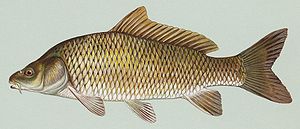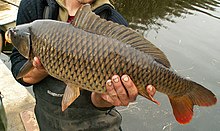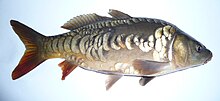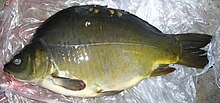carp
| carp | ||||||||||||
|---|---|---|---|---|---|---|---|---|---|---|---|---|

Common carp |
||||||||||||
| Systematics | ||||||||||||
|
||||||||||||
| Scientific name | ||||||||||||
| Cyprinus carpio | ||||||||||||
| Linnaeus , 1758 |
The carp ( Cyprinus carpio ) is one of Europe's fish species and as the type species of the genus Cyprinus both in German and in the jargon name to the family of carp fish (Cyprinidae), the superfamily of carp fish-like (Labroidei) and the order of Cyprinids (Cypriniformes) . It has been a popular food fish since ancient times , which is often attracted to fish ponds and has also been introduced into numerous countries around the world, where it sometimes occurs as an invasive species . In contrast, the wild population is now considered threatened.
features
Wild form
The wild form of the carp is elongated and laterally slightly flattened with a completely scaled body. The back is olive green with lighter flanks and a yellowish to whitish belly. Carp usually reach a length of 30 to 40 centimeters, in individual cases they can be up to 120 centimeters long and weigh over 40 kilograms. The current record carp, which was caught on November 23, 2018 at the Hungarian Euro Aqua lake, weighed 51.2 kilograms.
The head is elongated and conical with a small eye and a mouth that can be turned out into a trunk. Like all other carp fish, the carp has no teeth on its jaw, instead it has three rows of strong, molar-like pharyngeal teeth , of which the two outer rows have one and the innermost three teeth on each side of the jaw (pharynx formula 1.1.3-3.1.1). In contrast to the other carp fish found in Europe, it has two pairs of barbels on the sides of the upper lip, of which the front pair is shorter. The scales are very large and strong. An uninterrupted sideline runs through 33-40 scales along the flanks . The long dorsal fin has 3 to 4 hard and 17 to 23 soft rays, the anal fin has 2 to 3 hard and 5 to 6 soft rays. The caudal fin is deeply notched and has three hard and 17 to 19 soft rays. All of these unpaired fins are opaque dark gray to brownish with a bluish tinge. The paired pectoral and pelvic fins , on the other hand, can also be reddish. The former have one hard and 15-16 soft rays, the second two hard rays and 8 to 9 soft rays.
In the past, the European carp was often compared as the subspecies Cyprinus carpio carpio to the East Asian subspecies Cyprinus carpio haematopterus . The latter, however, is now mostly regarded as a separate species, Cyprinus rubrofuscus . This species differs from the European carp in that it has fewer scales along the side line, a higher number of dorsal fin rays and a silvery body color with reddish lower fins.
Cultivated forms

The different cultivated forms of the carp are usually more stocky and more or less pronounced high-backed. They also usually grow faster than the wild form. The scales can be reduced to different degrees, whereby the following shapes can be distinguished.
- Scale carp still have a completely preserved scale dress.
- Zeilarpfen have fewer scales, a row of large scales are preserved along the sidelines.
- Mirror carp only have a few scales distributed over the top on the otherwise scaly sides.
- Leather carp or naked carp are scaly.
- Two Toned Carps are mirror or scale carp that have a characteristic two-tone pattern. Mostly they have a darker head and a lighter rear part.
- Fully Scaled Mirror carp are regularly fully scaled mirror carp or line carp, which are of the highest priority among carp anglers.
- Ghost carps are hybrids of mirror carp and koi carp, which are a targeted breeding product and do not occur naturally in this form.
- F1 carp are carp of the F1 daughter generation, a cross between common carp and crucian carp , which, due to their rapid growth, are often set in commercial fishing ponds
The East Asian colored carp ( Koi ) are cultivated forms that probably go back to Cyprinus rubrofuscus or hybrids .
Genome
The genome of Cyprinus carpio consists of 100 chromosomes (2 n = 100) with 52,610 protein-coding genes. That is more than twice as many as in humans. A research team led by Xiaowen Sun from the Chinese Academy of Fishery Sciences deciphered it by 2013.
distribution
The post- glacial distribution area of the ancestral form of the domesticated carp included the tributaries of the Black Sea , Caspian Sea and Aral Sea . This water system includes the Danube in the west and extends over large parts of Siberia and China in the east . The uncertain subspecies Cyprinus carpio haematopterus in East Asia and Cyprinus carpio carpio in East Europe testify to this wild carp distribution . Historically, the distribution probably fluctuated depending on the climate. The carp also appeared in the upper reaches of the Danube 8000 years ago, and wild carp-like stocks of unclear origin are known in Lake Constance and formerly in the Neckar . The spread of the carp west of the catchment area of the Danube can be traced back to human influence. The species was introduced into numerous countries worldwide by humans. There it turns out to be a pest ( see list of the 100 most dangerous neobiota ).
A European research team published a study in 2020 that a small proportion of carp eggs survived digestion in mallards (approx. 0.2 percent). So far, this has only been considered possible for some tropical fish species. An influence of this mechanism on the invasive spread of the carp has been discussed in some places, but assessed as minor.
Way of life
Habitat
Carp are planted in warm, shallow fresh water , such as ponds , quarry ponds , and slow-flowing warm areas of rivers . They go into the brackish water region of the great rivers. Wintering takes place in deeper areas of lakes or in special, deeper wintering ponds for pond farming, which cannot freeze right through to the bottom.
nutrition
As a coarse fish , the carp feed on zooplankton as a young animal, later mainly on small organisms living on the ground such as insect larvae, snails and worms. In Spain, however, it has been observed that large carp, in particular, are sometimes predatory and devour smaller white fish.
Reproduction
Among fishermen, the females are called Rogner and the males are called Milchner . To mate, the carp meet in shallow, warmer and plant-rich water areas. The male drives the female in the spawning game. It serves to synchronize readiness for spawning. After driving, the male hits the female's flank several times with its mouth. This then releases eggs into the water. Then the male adds his semen. External fertilization takes place in the water. The female lays around 1.5 million eggs, depending on age and size. The fertilized eggs attach themselves to plants. After spawning, the parent fish swim back to their original waters. There is no brood care. The mucous membrane of the fish is often severely injured during such mating games. After the spawning season, dead fish that have fallen victim to a fungal infection are often driven.
Between the third and eighth day, the brood hatches headfirst from the egg shell. The fish sink to the bottom because the swim bladder is not yet filled with a gas mixture. A short time after hatching, they still feed on the yolk sac on their belly, which is gradually consumed. Then they begin to take in planktonic small animals , first the smaller rotifers , and as they grow up also small crustaceans .
Carp and human
history

There is evidence that the Romans first domesticated the carp: In the first century AD they got to know the wild form near Carnuntum on the Danube, which spawned in the huge floodplains of Hungary. From there the Romans transported it alive over land (in damp moss or other moisture storage) and kept it in basins until it was prepared. For keeping and later breeding (from the 2nd or 3rd century) they used immobile piscinae (fish, swimming pools) and mobile irrigated fish holders, so-called troughs - these are floating vessels that resemble dugouts . Regardless of this, breeding in China cannot be ruled out either, but carp domestication is largely attributable to the Romans.
The carp culture in fixed fish tanks was continued in the Middle Ages . Increasingly, carp were kept in ponds. The carp is therefore an essential part of the food culture in the Middle Ages . The stocking of ponds with carp was partly a secondary use because the ponds were mainly used to retain water to drive mills. Due to the extensive Christian dietary laws , which did not allow meat to be consumed on up to 150 days of fasting, a systematic pond management was developed to raise freshwater fish for Lent. It is not certain which factors contributed to the fact that carp were also found in Central and Western Europe after the year 1000. The global warming in the transition phase from the early to the high Middle Ages may have contributed to the fact that this species of fish spread naturally. The ethnologist Brian Fagan thinks it is more likely that monks and nuns introduced this species of fish purposefully in order to diversify their diet during Lent. Carp also thrive in water with a low oxygen content and are therefore ideal for breeding in shallow ponds. Some monasteries and aristocrats owned some very extensive pond farms in which these fish were raised for Lent. The traces of these ponds shape parts of the European landscape to this day and are an indication of the importance of freshwater fish in the medieval diet. For example, traces of around a dozen large fish ponds can still be found in the vicinity of Maulbronn Monastery . The 400 square kilometers of ponds around the Bohemian Třeboň , which began in the Middle Ages, are still used today for carp breeding.
Today's spread of carp farming
In Germany there are numerous carp farms, especially in Upper Lusatia north of Bautzen , in Franconia in Aischgrund ( district Neustadt an der Aisch-Bad Windsheim , district Erlangen-Höchstadt ), in the central Upper Palatinate in the district of Schwandorf and in the district of Amberg-Sulzbach , im Upper Palatinate Stiftland ( Tirschenreuth district ) as well as in Peitz , not far from Cottbus and in Reinfeld in Holstein.
The largest pond area in Europe economically used for carp breeding is the Upper Lusatian Heath and Pond Landscape , whose 335 ponds take up almost ten percent of the 30,000 hectares. The largest carp pond (Schwarzenberg pond with an area of 260 hectares) is located in the South Bohemian carp pond area near Třeboň (German: Wittingau). This area is geographically related to the Austrian pond area in the Waldviertel . Important Austrian carp areas are also located in southern Styria and southern Burgenland .
Carp pond farming is of greater importance in Poland , Hungary , Slovenia and Croatia as well as in Israel and large parts of Asia.
Only in Australia is the breeding and release of carp prohibited by law. There an attempt is being made to eradicate the carp as a pest of the native fauna through a program in which genetically modified carp are released and crossed into the feral populations. As a result, all carp should ultimately remain male (as they are naturally in the hatching stage) and no longer be able to carry out the developmental step to transform into female animals.
Carp as a heraldic animal
The carp is the heraldic animal of several cities and towns that can boast a long history of carp farming.
Carp stone
The carp stone is the fish's chewing plate and has the anatomical seat between the recess of the occipital bone and the carp's first vertebrae. It is a cartilaginous bone called carp stone ( lapis carpionis ). The carp stone is arched, somewhat lenticular, triangular and hard. The color is light to gray. Nice pieces of not too old carp can be polished and made into chains. In the Middle Ages there was a rumor that only some carp had a carp stone, which is why an aura grew around the stone, "The stone was ascribed healing properties and magical powers. People rubbed the carp stone and mixed it with food ... Against stomach ache, Cholics, even against nosebleeds and those with bad eyesight, gave the powder the powder. As an amulet around the neck, the stone was supposed to protect against disease and ruin ". The belief that putting a New Year's carp stone in your wallet means that you have money available all year round has a similar background.
Carp as edible fish

Carp are popular food fish , especially at Christmas and New Year's in Germany and Austria. A large part of the production from pond farming therefore goes into the market for edible fish. The production of fish for fishing in open waters has a significant share.
Especially in Bohemia and the neighboring Austrian Waldviertel, carp is a popular food fish ( Christmas carp) , especially at Christmas - for some Czechs Christmas without carp is still unthinkable. It is sold alive, first slaughtered at home and usually breaded and served with lemon . There are five to ten different preparations on the menus of Czech inns, for example cooked in a spice stock, grilled, spicy with paprika vegetables.
In Germany there is a stronghold of carp in Franconia. The " Aischgründer Karpfen" are a well-known specialty of the area. Here the carp, including the head and fins, is split lengthways in half, turned in flour and baked in floating fat ("Franconian carp"). The fins are crispy and edible. Another typical Franconian dish is carp in beer sauce.
In Schleswig-Holstein and Lusatia , cooked carp ( blue carp ) is a popular New Year's Eve dish .
Like mussels, carp are eaten in the months with r , from September to April. Although carp is also available outside of this period, this tradition is largely maintained.
In Germany and Austria, attempts are being made to circumvent the carp's greatest disadvantage, its enormous wealth of intermuscular bones, with special preparation methods such as lateral incisions called " cupping ". New forms of marketing similar to fish fingers are tried. The success is moderate.
The taste of the fish itself is also controversial among gourmets . Some call it strawy or simply bland. Others, on the other hand, appreciate its “nutty” aroma. The taste and consistency of the carp strongly depend on the keeping conditions and the additional feeding used (grain, maize, soy, pellet feed). In addition to the correct preparation, the water quality in the last few days before killing the animal is important. If the fish is prepared directly from the water of origin, it often tastes strawy or muddy. The fish must therefore be kept in fresh water beforehand. It is recommended to remove the gills, as this sludge in particular accumulates and can negatively affect the taste of the dish.
A common, unpleasant muddy-earthy taste impairment , Mooseln or Letteln , known in Austria as gobies , is notorious . It occurs when the fish ingest certain blue-green algae that contain what is known as geosmin . These are the pond fibrillator Oscillatoria limnetica or its genus relatives, which when the ponds are overfertilized with phosphate grow flat on the bottom where the carp typically look for their food. That is why carp are usually kept in fresh water for about two weeks without additional feeding (“watered out”) so that they lose this aftertaste as much as possible.
Carp in sport fishing
The carp is very popular with anglers because it is a strong fighter, grows very large and can be angled very selectively with boilies . The carp fishing has evolved in recent years into a major branch of angling, investigate the many, especially younger anglers. Fish (depending on the body of water) weighing over 10 to 15 kilograms are considered a remarkable catch. The world record for mirror carp was set in 2015 at the Euro Aqua lake in Hungary, it is 48 kilograms with a length of 125 centimeters. The new world record common carp weighing 45.5 kilograms was caught in 2013 in the French “Etang de Saussaie”. In carp fishing, it is common to release the catch again. This catch and release is in conflict with the Animal Welfare Act , as it causes suffering to vertebrates for no good reason. Officially, fish may only be released in accordance with the conservation objective (e.g. endangered stock) and animal welfare law.
Carp fishing is not considered easy as it takes considerable experience and knowledge of the water to catch particularly large specimens. If young, hungry set carp are relatively easy to catch in spring from a water temperature of 8 ° C, a different strategy is often useful for shy and cautious large carp. Carp fishing begins with the intensive observation of the water at different times of the day and year for carp tracks, such as the development of bubbles from carp pounding at the bottom of the water or trembling reed stalks from contact with carp. Particularly suspicious places are reed edges, water lily fields, weed parts of water, islands, headlands, sunken trees, overhanging branches etc. Sand banks, plateaus, mussel fields and sharp edges are discovered by sounding out (plumb bob or echo sounder ). Afterwards, the feeding period of several days (such as boilies , bread, hard corn, particles, tiger nuts , chickpeas, or swollen wheat) begins at a certain time of the day over several days in order to get carp used to the bait or the place.
Before the boilie era, carp with potatoes, specially flavored doughs made from breadcrumbs, cornmeal, oat flakes, etc., canned corn, dung or thaw worms were caught on a ground or float fishing rod. However, boili fishing with the unsuspecting hair method brought ever larger carp catches, even from overfished waters. With the hair method, the bait is connected to the hook by a "hair" (very fine cord), so that a cautious large carp sucks the unsuspecting bait and the hook with it. When digging and rummaging through the bottom of the water, larger carp ignore a heavier bait with a hook that is not thrown up with it. Sometimes it has already been observed in clear waters that carp try to carefully pluck the bait from the hook.
In the warm summer months, carp regularly stand on the surface of the water, mostly under overhanging branches of trees and can be outwitted with swimming bread, for example. Remarkable catches of over 20 kilograms are also possible with this method. The shy carp often retreat to inaccessible stretches of water: heavily weedy bays, fields of water lilies, sunken trees or flooded undergrowth, where they can hardly be caught. Hooked animals try to get themselves to safety in inaccessible areas with all their might, although heavier animals can muster considerable strength, which is why cords with a load capacity of over 10 kilograms are a must.
literature
- Werner Steffens: The carp. Cyprinus carpio L. 6th edition, Westarp-Wissenschaften, Hohenwarsleben 2008, ISBN 978-3-89432-649-4 .
- Fritz Bauerreiß (Ed.): Fränkischer Karpfenführer: Kleines Karpfenlexikon - Typical pictures from the carp country Franconia. Verlag Bauerreiß, Fritz 2011, ISBN 978-3000356940
Web links
- Cyprinus carpio in the endangered Red List species the IUCN 2008 Posted by: J. Freyhof, M. Kottelat, 2008. Accessed on December 31 of 2008.
- Carp on Fishbase.org (English)
- Fisheries & Aquaculture - Cultured Aquatic Species Information Program: Cyprinus carpio (Linnaeus, 1758)
- Carp on www.pivi.de
Individual evidence
- ↑ Hungary. World record: carp over 100 pounds. BLINKER 02/2019, p. 11
- ↑ a b Roland Gerstmeier, Thomas Romig: The freshwater fish of Europe for nature lovers and anglers . 2nd Edition. Franckh-Kosmos, Stuttgart 2003, ISBN 3-440-09483-9 , pp. 288-292 .
- ↑ Günther Sterba : Freshwater fish of the world . 2nd Edition. Urania, Leipzig 1990, ISBN 3-332-00109-4 , p. 275-276 .
- ↑ Carp on Fishbase.org (English)
- ↑ a b Maurice Kottelat , Jörg Freyhof : Handbook of European Freshwater Fishes . Publications Kottelat, Cornol 2007, ISBN 978-2-8399-0298-4 , pp. 147-148 .
- ↑ a b c d carp current. The Rüßler gang. He is several thousand years old, traveled from Iran via Asia to Germany and has an infinitely long family line: the carp. BLINKER 11/2017, pp. 26-29.
- ↑ Xiaowen Sun ea: Genome sequence and genetic diversity of the common carp, Cyprinus carpio. Nature Genetics , September 21, 2014, accessed September 22, 2014 .
- ↑ khü: Fish genome: researchers decipher carp genome. Spiegel Online , September 22, 2014, accessed September 22, 2014 .
- ↑ a b c d e f g Eugene K. Balon: Origin and domestication of the wild carp, Cyprinus carpio: from Roman gourmets to the swimming flowers. In: Aquaculture , Vol. 129, No. 1, Jan. 1, 1995, pp. 3-48, doi: 10.1016 / 0044-8486 (94) 00227-F .
- ↑ a b c Jian Feng Zhou, Qing Jiang Wu, Yu Zhen Ye, Jin Gou Tong: Genetic divergence between Cyprinus carpio carpio and Cyprinus carpio haematopterus as assessed by mitochondrial DNA analysis, with emphasis on the origin of European domestic carp. In: Genetica , Vol. 119, No. 1, September 1, 2003, pp. 93-97.
- ↑ Invasive Species: Carp invasion through the duck intestine. Retrieved June 28, 2020 .
- ^ A b Eugene K. Balon: The common carp, Cyprinus carpio: its wild origin, domestication in aquaculture, and selection as colored nishikigoi . In: Guelph , Ontario, Canada 1995 ( Guelph Ichthyol. Rev. Volume 3), PDF .
- ↑ James Arnold Higginbotham: Piscinae: Artificial Fishponds in Roman Italy . UNC Press Books, 1997, ISBN 978-0-8078-2329-3 .
- ↑ Ronald Bockius: The Roman Fish Holders (Bünnen) from Zwammerdamm , June 16, 2018.
- ↑ G. Füllner: The domestication of the carp . PDF
- ^ Brian M. Fagan: Fish on Friday. Feasting, Fasting and the Discovery of the New World. Basic Books, New York 2007, ISBN 978-0-465-02285-4 , p. 135
- ↑ Hansjörg Küster: History of the landscape in Central Europe. Beck, Munich 1995, ISBN 3-7632-4520-0 , p. 226
- ↑ Karpfenstein am Hals HANNI KINADETER, Nordbayern.de, March 13, 2014
- ↑ http://www.euro-aqua-fishing.at/main_site/index-old.htm
- ↑ http://www.carpzilla.de/news/szene-news/neuer-schuppenkarpfen-weltrekord-455kg-1502.html
























